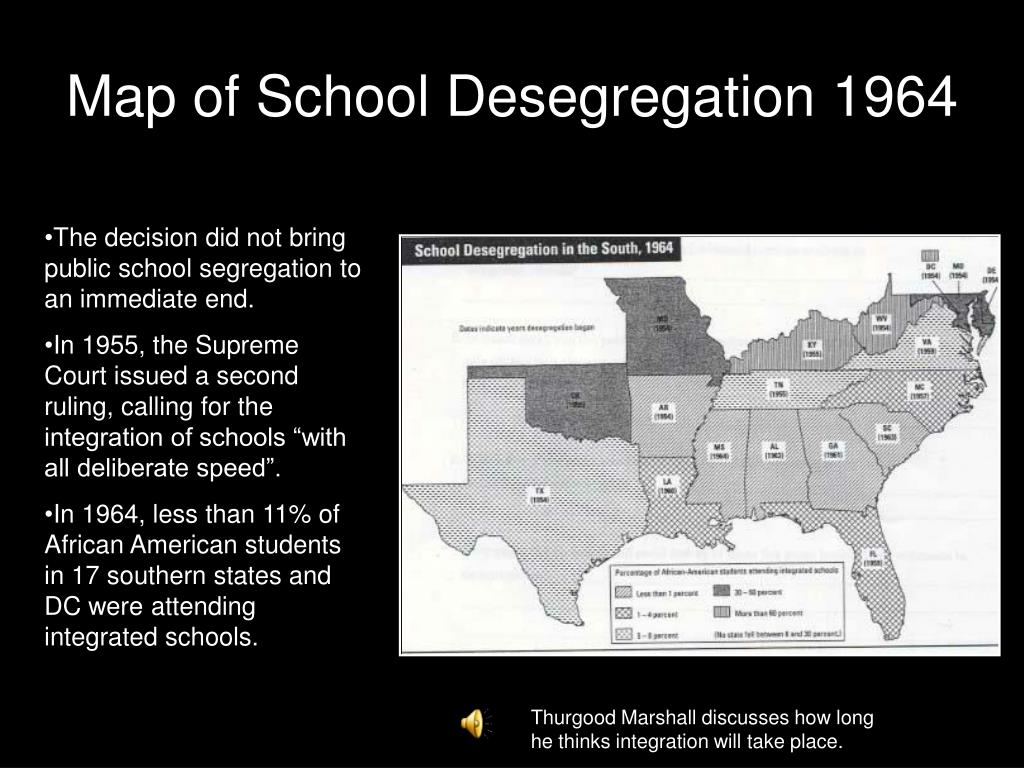The Fallout From The Justice Department's School Desegregation Decision

Table of Contents
Immediate Reactions to Desegregation Orders
The Justice Department's efforts to enforce desegregation faced immediate and fierce resistance, particularly in the South. The implementation of Brown v. Board of Education, which declared state laws establishing separate public schools for black and white students to be unconstitutional, was met with widespread defiance.
Southern Resistance
The South's response to desegregation was characterized by "massive resistance," encompassing a range of tactics aimed at obstructing integration.
- Legal Challenges: Southern states employed numerous legal strategies to delay and circumvent desegregation orders, filing appeals and exploiting loopholes in the law.
- Protests and Violence: Significant resistance manifested in the form of protests, boycotts, and even violence directed at Black students and their families attempting to integrate schools. The infamous example of the Little Rock Nine, where nine Black students were met with violent opposition as they attempted to enter Central High School in 1957, remains a powerful symbol of this resistance.
- The Closure of Public Schools: In some instances, entire school districts were temporarily closed rather than comply with desegregation orders. This "massive resistance" strategy aimed to pressure the federal government to back down. These legal battles over desegregation stretched on for years, delaying the implementation of desegregation in many parts of the South.
Northern Challenges
While the South witnessed overt resistance, the North faced its own challenges in achieving school integration. De facto segregation, stemming from residential patterns and discriminatory housing policies, resulted in highly segregated school systems despite the absence of explicit legal mandates.
- De facto segregation: This form of segregation was less easily addressed legally, as it was not based on explicit laws but on deeply entrenched social and economic inequalities.
- Unequal School Resources: Even in nominally integrated schools, significant disparities in resource allocation often persisted, with minority schools receiving less funding and fewer opportunities than their predominantly white counterparts. These unequal school resources contributed to the ongoing achievement gap.
Long-Term Impacts on Education
The long-term effects of the Justice Department's school desegregation decisions are complex and multifaceted, impacting both academic achievement and broader social and economic realities.
Academic Achievement
While desegregation aimed to improve educational outcomes for Black students, the impact has been uneven.
- Achievement Gaps: Although some studies have shown positive correlations between desegregation and improved academic outcomes for Black students, significant achievement gaps persist to this day.
- Positive Outcomes: In some cases, integrated schools fostered a richer learning environment, exposing students to diverse perspectives and fostering social interaction between different racial groups.
- Persistent Challenges: However, factors such as unequal access to resources, teacher quality, and implicit biases within the education system continue to hinder the educational success of many minority students. The impact of integration on education remains a topic of ongoing research and debate.
Social and Economic Impacts
The consequences of desegregation extend beyond academic performance, influencing social and economic realities.
- Social Cohesion: While desegregation aimed to promote social cohesion, the integration process often encountered significant social resistance, leading to strained interracial relations in some communities.
- Economic Mobility: The impact of school desegregation on economic mobility is complex and debated. While improved educational opportunities can enhance economic prospects, systemic inequalities continue to limit opportunities for many.
- Racial Attitudes: Desegregation has had a complex and evolving impact on racial attitudes. While some evidence suggests improved racial tolerance, significant prejudice and discrimination remain. The social impact of desegregation continues to be felt in various aspects of American society.
The Ongoing Debate and Current Challenges
The principles established by the Justice Department's actions in promoting desegregation continue to shape contemporary debates about educational equity.
Modern Applications of Desegregation Principles
The fight for equal educational opportunities continues.
- Contemporary School Segregation Issues: De facto segregation persists in many communities, necessitating ongoing efforts to address school funding disparities and create more equitable educational systems.
- School Choice and Funding Equity: Debates about school choice and funding mechanisms often revolve around the question of how to best ensure equitable access to quality education for all students, regardless of race or socioeconomic background.
- Addressing Racial Inequalities in Education: Current efforts to address racial inequalities in education include initiatives to improve teacher training, promote culturally responsive teaching, and address implicit bias within educational institutions.
The Legacy of the Justice Department's Role
The Justice Department's role in school desegregation has a complex and lasting legacy.
- Successes and Failures: While progress has been made, significant challenges remain in achieving true educational equity.
- Key Lessons Learned: The experience underscores the need for sustained commitment to address systemic inequalities, providing adequate resources, and fostering inclusive educational environments.
- Ongoing Need for Equitable Education: The struggle for equitable education remains a crucial component of the fight for racial justice. The Justice Department’s legacy, both its successes and failures, should inform our continuing efforts to create more equitable educational opportunities for all children.
Conclusion
The Justice Department's school desegregation decisions had immediate and profound consequences, met with fierce resistance in the South and more subtle but equally impactful challenges in the North. The long-term impact on academic achievement and broader social and economic realities remains complex and uneven, with significant progress made but persistent inequalities remaining. The ongoing debate surrounding school choice, funding equity, and addressing racial disparities in education highlights the unfinished work of ensuring equitable educational opportunities for all. Understanding the fallout from these school desegregation decisions is crucial for developing effective strategies to address persistent racial inequalities in education today. We must continue to learn from the past to build a more equitable future by engaging in local school initiatives, supporting organizations advocating for educational equity, and demanding policy changes that address the ongoing impact of the Justice Department's school desegregation policies.

Featured Posts
-
 Nieuw Schoolgebouw Kampen Stroomnet Aansluiting Geblokkeerd Kort Geding Gestart
May 02, 2025
Nieuw Schoolgebouw Kampen Stroomnet Aansluiting Geblokkeerd Kort Geding Gestart
May 02, 2025 -
 International Harry Potter Day Where To Buy Official Harry Potter Products Online
May 02, 2025
International Harry Potter Day Where To Buy Official Harry Potter Products Online
May 02, 2025 -
 Key Moments Duponts Performance In Frances Rugby Victory
May 02, 2025
Key Moments Duponts Performance In Frances Rugby Victory
May 02, 2025 -
 Backwards Music In Fortnite Player Backlash And Demands For Reversal
May 02, 2025
Backwards Music In Fortnite Player Backlash And Demands For Reversal
May 02, 2025 -
 Remembering Priscilla Pointer A Legacy Of Acting And Mentorship
May 02, 2025
Remembering Priscilla Pointer A Legacy Of Acting And Mentorship
May 02, 2025
